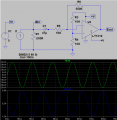I'm using this inverter reference design from TI for my design but I'm unsure of how to correctly sense the circuit current.
As shown in the provided schematic below, they use hall effect sensor.
For my own design, I'm using current transformer but I'm unsure if the interfacing to the microcontroller would be pure dc or ac(with positive offset). Which is okay for the control?
If it would be the ac, is it at the line frequency or the switching frequency of the full bridge?
Thank you.

As shown in the provided schematic below, they use hall effect sensor.
For my own design, I'm using current transformer but I'm unsure if the interfacing to the microcontroller would be pure dc or ac(with positive offset). Which is okay for the control?
If it would be the ac, is it at the line frequency or the switching frequency of the full bridge?
Thank you.








